Find Solutions in Our Knowledge Base
The top 10 best content management systems in 2022!
In 2022, We don’t need to hire Web Developers to create websites. We can use the CMS Platforms that allows us to create beautiful websites without any technical . There are 15+ Content Management Systems available on the internet. Most of them are free and easy to use. In this article, we will learn the critical comparison between different CMS Platforms. But, How can we choose the best CMS platform to build our website? To determine the best CMS for our site, we need to understand all the advantages and disadvantages of all the popular CMS options available for us.
What is CMS (Content Management System) Platform?
A CMS platform (Content Management System) allows you to create and manage web content and web pages easily. Generally, web developers write code to create web pages and the functionality of the website. However, With the use of Content management system, you can easily create a website or a blog without any technical knowledge of writing code in HTML, CSS, JS and PHP.
Many of them are here because of the simplicity they offer. Many CMS platforms offer you to create and manage the web pages with drag-and-drop facility. But before you choose the best CMS for your next project, let’s understand the criteria of a good and reliable CMS. So let’s know the basic standards of an ideal CMS platform.
Ease of Use
We always want a CMS platform that is easy to use and understand. We need a CMS platform that makes our task manageable, like Create and Edit the web content. It must have the element drag and drop interface so we can add elements anywhere on the page. It should be fast and effective to build an attractive website in a couple of days.
Design Options
Default Templates and Designs are also an effective criteria when it comes to selecting a content management system. The CMS platform must have some design options for different uses. And, better if we can also customize the template or design. So, we can create our design and create attractive web pages with personal twist.
Different content management systems provide different methods to change the design of the site. Usually, you can find “CMS themes” or “CMS templates” on the internet to find available options.
Data Management
Another Criterion that matters is How we can use our website’s data? An idol CMS platform must have supportive tools which can help us to export our website’s data and also import it. So, we can use that data for our other purposes. Also, the data portability will make your work easy in case of Hosting transfer.
The another thing is, it should understand the basic variables from a specific post or a page. So that we can display the content on a template and we don’t have to create a new page for each and every post.
Extensions/Add-ons
Not every CMS platform is perfect. It isn’t easy to choose the CMS platforms when we need extra facilities for ease of use and fulfill our requirements. The extensible CMS platform is the solution for it. With that support, we can add other third-party software which can be free and paid too. With that, we can add additional features and extend our website.
Support
As we know, a CMS platform must have an easy interface. Also, it must have a possible straightforward method that it will use to create a website. And when something goes wrong on the system, you must get sufficient support to recover from the issue. On some popular Open-source CMS, you will get community support. And some communities like WordPress community are huge! You can quickly find the solution of any problem on the internet.
However, On paid CMS, you are paying a subscription, So you are also paying for support.
Cost
Cost is one of the most effective criteria when we are looking for the best CMS platforms. Some CMS platforms are free and open-source, but some of them come with monthly charges. And, we also need to count the future cost when the site grows.
Also, calculate the cost of extensions and other Hosting charges. So, you must know the total cost of the CMS platforms. We will compare the price of each CMS platform.
1. WordPress.org
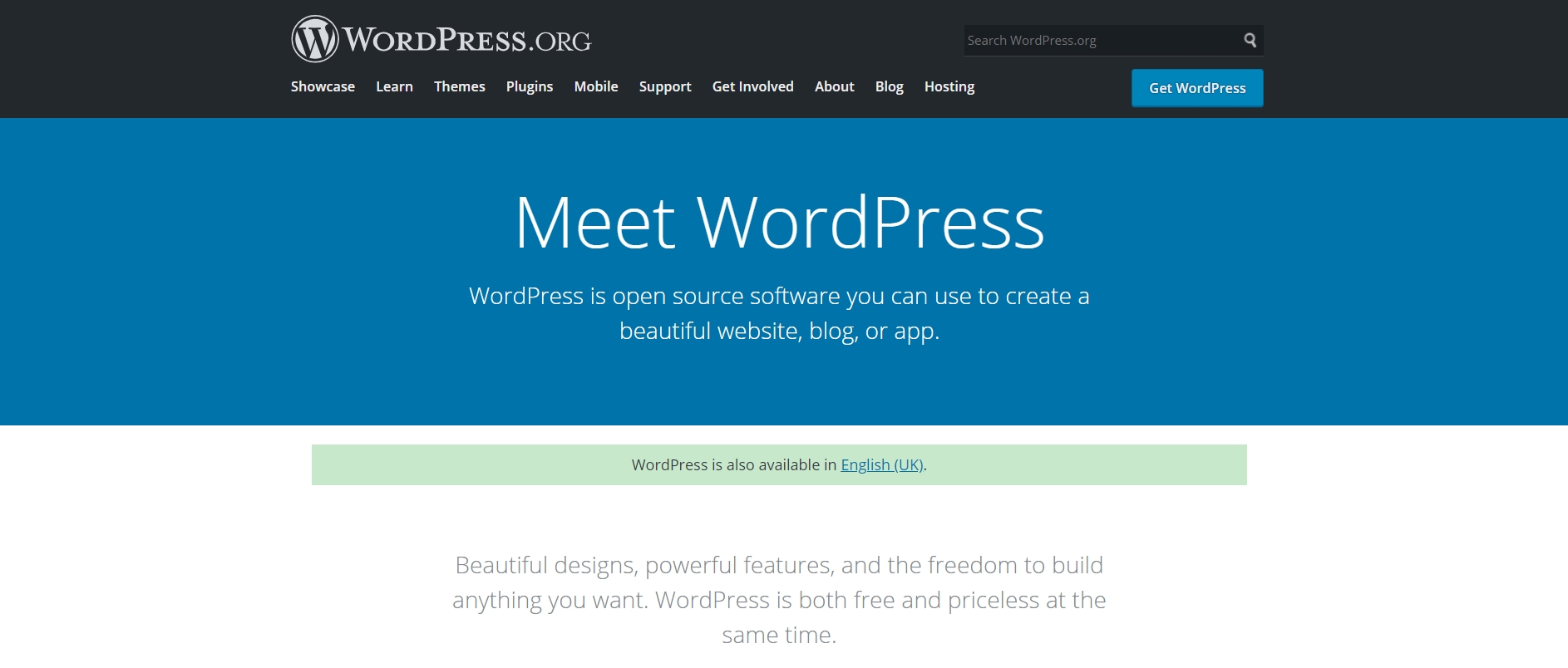
WordPress.org is our first choice for this list. It is the most popular CMS platform and already powers more than 40% of the websites on the internet. It is easy to understand and reliable too. The critical point is, do not to confuse WordPress.com with WordPress.org. WordPress.com is a blog hosting platform. WordPress.com is powered by WordPress content management system itself, but it provides monthly subscriptions and allows limited customisations.
However, If you go to WordPress.org, you will see a download button to freely download the latest version of WordPress. WordPress.org is an Open-Source platform that is created in PHP.
It was initially created for Blogging purposes. But now, You can practically create any kind of website on WordPress. Also, it provides a library of free themes and add-ons. Let’s see its pros and cons one by one.
Pros
- WordPress is so flexible that we can build any type of website. We have complete freedom because we can create websites like Blogs, portfolios, E-commerce websites, Business websites, etc., with WordPress.
- It doesn’t require any technical or coding skills to create a website. WordPress provides a block editor, This is very easy to use, and we can build attractive web pages with ease.
- WordPress.org is an open-source CMS platform which means you can create a website for free and make money with it. You can modify it according to your requirements.
- WordPress also provides thousands of different themes and add-ons plugins. You can find paid and free plugins and themes in the WordPress Repository. These libraries will help you to extend your website usability. You can add many features like forms, security improvements, and media galleries.
- WordPress is also designed for SEO(Search Engine Optimization). It means you can have SEO-friendly URLs and you can find all the plugins in WordPress repository to create a fully SEO-friendly website. You can add many plugins which can help you to create an SEO-friendly site.
- A vast community is available for support with WordPress.org. We can join the groups and Community for the solutions and problems related to the WordPress website.
- WordPress website is truly extensible with third-party add-ons support. That’s why WordPress is an ideal CMS platform for beginners and developers.
- Migration of a WordPress site is easy. It is very popular, So many web hosting companies will help you migrate your WordPress site for Free!
Cons
- After the site creation, we need a Domain name and Hosting space to make the WordPress site live on the internet. And the user is only responsible for the website’s security and backups. We can solve this issue with the use of external plugins or a good WordPress web hosting company.
- WordPress offers block editing to design web pages, but sometimes it feels a little daunting. That’s why many WordPress users use the different page builders, which offer element drag-and-drop facility.
Pricing
- WordPress is an open-source CMS platform, so it doesn’t cost anything. However, we need a Domain name and hosting account to host a website online. The total cost of the domain and hosting is around 8 US dollars per site, cheaper and better if you go with WebHostingPeople web hosting (Link given above).
- However, The pricing also depends on the web hosting company. If you go to a specialized WordPress web hosting vendor, you have to pay a lot more than a standard web hosting account with does almost the same thing.
2. Drupal
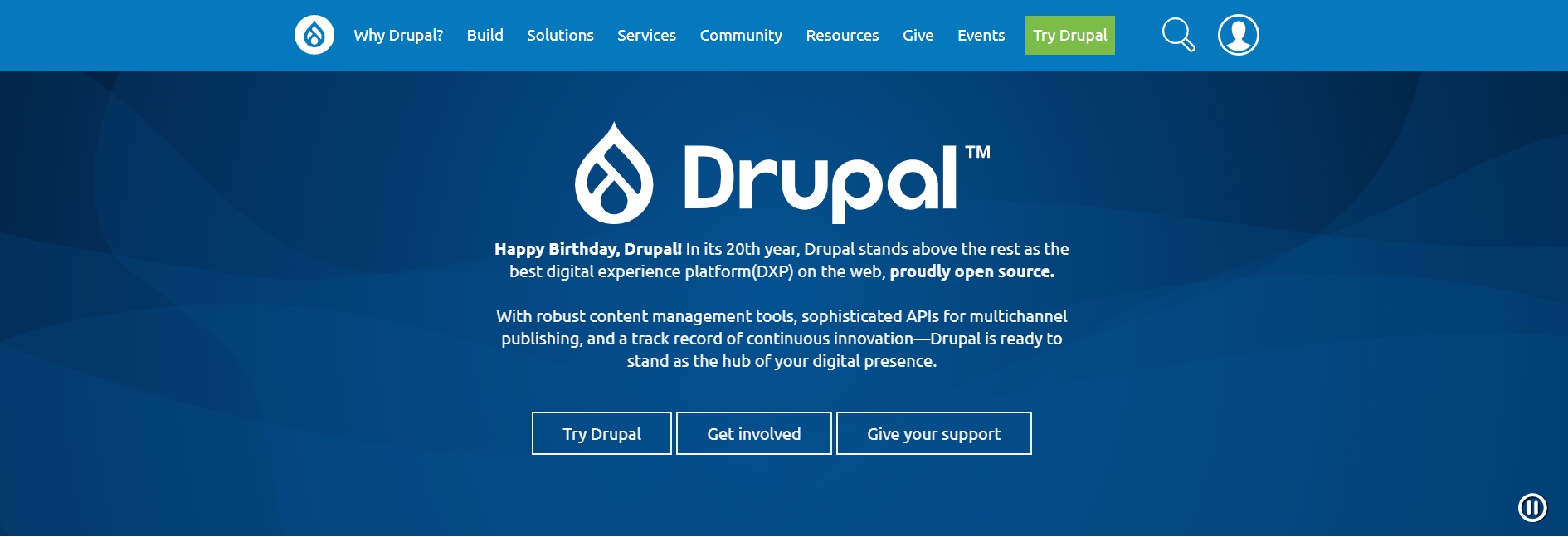
Just like WordPress.org, Drupal is another open-source CMS platform. Many Websites, including Economist and major universities’ websites, are already using the Drupal CMS for their website. Drupal is a good CMS for developers because Drupal is so famous for customization support and also for handling huge amount of data.
We offer free installation and also help you to transfer the existing Drupal website. Let’s see the Drupal CMS platform’s pros and cons one by one.
Pros
- The Drupal platform is an open-source and free to use. So, we don’t need to pay any money to download Drupal. We can use and customize the Drupal as per your requirement.
- As a developer, you can share the personalized codes in the Community. Even you can copy and use the code on Drupal to add more functionality to the site. Drupal has huge community members, including developers and well-wishers. Also, the Community allows you to interact with the site members and solve the doubts.
- Like other CMS platforms, it also delivers regular updates, fixes bugs, and keeps improving Drupal. Also, Drupal’s User management is so easy. We can easily modify the permissions.
- Drupal is the most secure CMS platform than any other CMS platform. Drupal didn’t allow third-party plugins and add-ons due to wrong thread and security reasons. Also, drupal’s security team always has an eye on the servers.
- Drupal is modern now; they regularly give us the latest updates like the trend. They also provide fully responsive and mobile-friendly themes. It can turn your website into a mobile friendly site completely.
Cons
- Downloading and using the Drupal CMS platform can be challenging without the help of developers because Drupal’s user interface is not so user-friendly. As we know, Drupal also has a vast library of themes and plugins. But sometimes, it’s hard to find suitable plugins and some of these modules are not even accessible.
- Drupal’s module or plugin’s library has limited modules compared to WordPress.
- Drupal’s Web development is not so easy. Before Drupal, you must know PHP, CSS, and HTML. Also, the Drupal framework has a huge learning curve compared to other CMS platforms.
Pricing
- Drupal is an open-source CMS platform, but you have to pay for the extra modules depending on your requirement.
- You also have to pay for Web hosting and the domain name. We provide Drupal Hosting for $2.5/month (For limited time!). And domain will cost you around $10 a year.
3. Magento
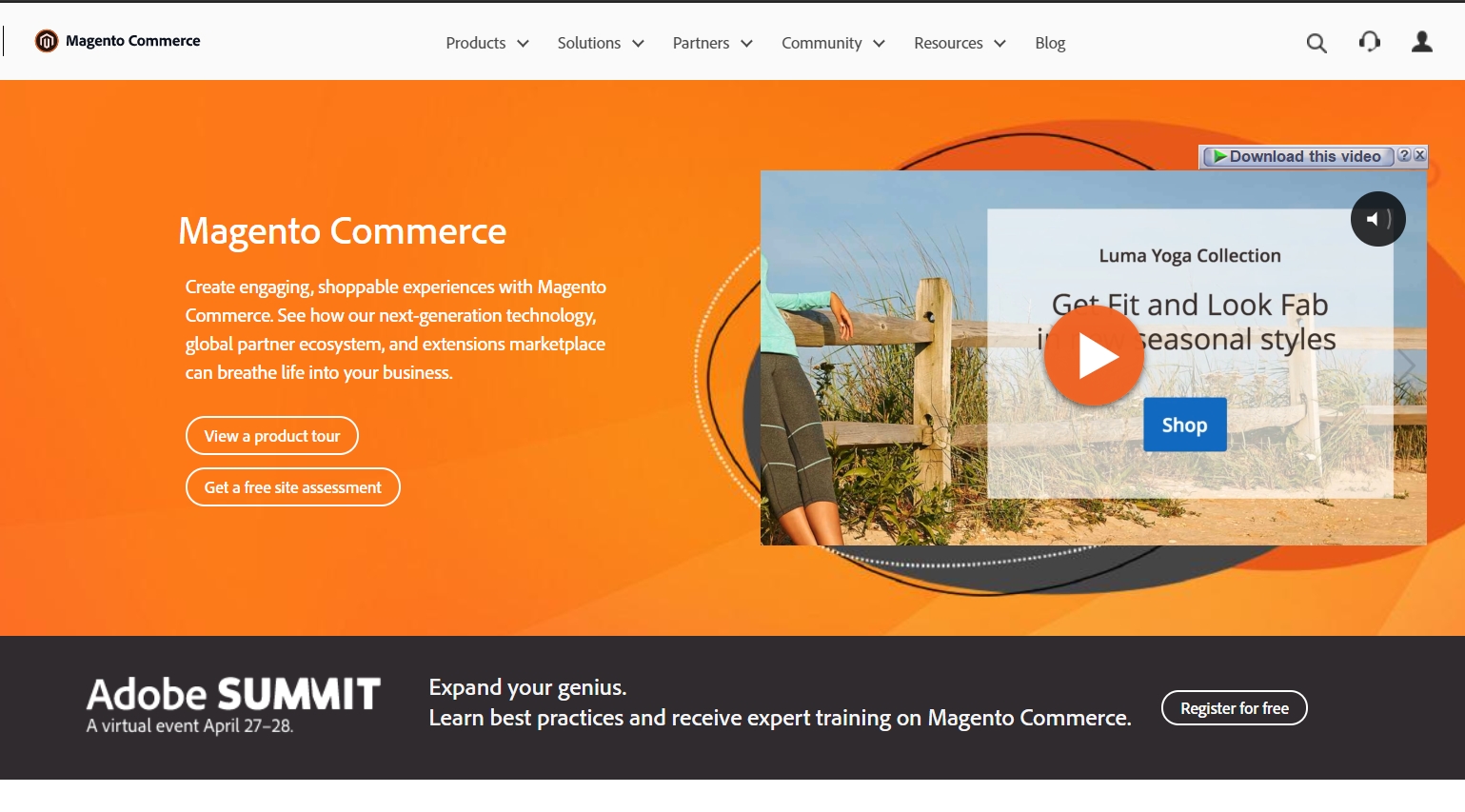
Magento is built in PHP, which helps users and developers create an E-Commerce website. It is also an Open-Source program by one of the most famous companies, Adobe. It was released on March 31, 2008, by Varien on Zend Framework. Many big websites are currently using Magento as an open-source E-Commerce platform to create their websites, Like Nike and Samsung.
Magento already powers 20% of the websites available on the internet. If you are thinking about a business or personal but Long-term professional e-commerce sites, Magento is the best CMS platform for you. It is a professional and free CMS platform. It also supports total customization, With drag-and-drop element management. So let’s see the Magento CMS platform’s pros and cons one by one.
Pros
- Magento is open-source software which means we can modify the codes and customize the templates as per our requirement. Magento is also flexible, and It also provides third-party integration so we can add extra features.
- It offers many features like multiple store management, Multiple location support, Multiple Language support, Multiple Currency support by default. The components they offer are essential features for an online E-store.
- Magento is the most popular E-commerce platform, So it also has considerable community support. It will help you to get a quick solution to the issue. These large number of communities also inspired to develop many extensions for Magento.
- With Magento, we can easily manage lots of products and customers. It also helps us to grow our business without slowing our website down.
- Magento has a mobile-friendly configuration, and it is also required to grow our business nowadays. Magento allows us to create mobile sites without difficulty and provides the best mobile viewing experience for website users.
- Another essential feature of Magento is, When our site grows in the future, Magento can smoothly scale up. Magento supports five thousand products and thousand transactions in one hour.
Cons
- Magento is available in many versions, and its community version is free and open-source. It comes with limited features. But it also has an Enterprise version which costs approximately fifteen thousand dollars per annum.
- As we know, Magento has large community users and developers. But Magento also has an extensive system that Processes over twenty thousand files and two hundred database tables. If we need to hire a Magento developer, it isn’t easy because of the extensive system. So the developer must have a couple of years of experience with Magento.
- Magento is difficult to understand, and if you’re a beginner, then the Magento will be overwhelming. It also has a slow loading time, and the customization is also pretty tricky for beginners.
- We need a dedicated server or a vps server to host a Magento site. It is because of the bulkiness of the Magento.
Pricing
- Magento is not cheap, and it has the highest cost ratio than other CMS platforms. Its enterprise version with full features will cost you around $22,000/per year. If you want a long-lasting business with pre-defined characteristics, then Magento will be an option to consider.
4. Shopify

Shopify is another most used CMS platform for E-Commerce websites. We can sell our digital and physical products online. Shopify also has more than one million active users, So, Shopify is one of the most popular CMS platforms. Spotify is an all-in-one solution. With Shopify we don’t have to buy hosting nor do we have to configure or install anything on the server. It comes as a Software as a Server and you have to purchase monthly/yearly subscription.
Shopify is one of the cheapest E-commerce solutions nowadays. We can create attractive websites with Shopify’s drag and drop interface. But it has some limitations for the customizations. It has different plans as per your requirements. The cheapest one you can get with $29. So, let’s see its pros and cons one by one.
Pros:
- Shopify is simple to use. You don’t have to hire a developer, and you can also create an online store in a couple of clicks with Shopify. Shopify will save your time, and you need to select a template and upload your products.
- Spotify is also good with support; Shopify has its team which solves the Shopify related issues 24/7. You can also get support via E-mail or live chat.
- Shopify also has lots of theme options in its theme library. You can choose a free or paid theme. You will find many templates categorized for different industries like Food, Jewellery, fashion, etc.
- Shopify also provides an App Store with almost 1200 plugins and apps. Most of the apps will configure themselves as per your E-store. Shopify offers its app store so that Shopify will easily do the time-consuming stuff and focus on work. You will find exciting apps which will manage your accounts and shipping.
- Shopify also provides marketing tools. As a result, more people will see your site and it will grow more. Shopify will allow you to make discount codes, and also you can link your product to social media.
- With Shopify’s Customizable website builder, you can modify your default website and give it a personal twist. Most of the themes allow modification.
Cons:
- Shopify’s cost is relatively high if you want to use third-party apps from the app store. Its advance plan comes with $299, and it offers advanced features of Shopify. But it’s too high for the small and medium-range business.
- Shopify has limitations in customization. You can’t customize a complete website, but it offers you to modify some website parts.
Pricing:
- Shopify offers you three plans according to the different sizes of the business. The basic plan is about $29, and it comes with basic features. Then the second plan will cost you $79 per month. Then Advanced Shopify plan, you can buy it for $299 per month, and it comes with a complete feature package.
5. BigCommerce
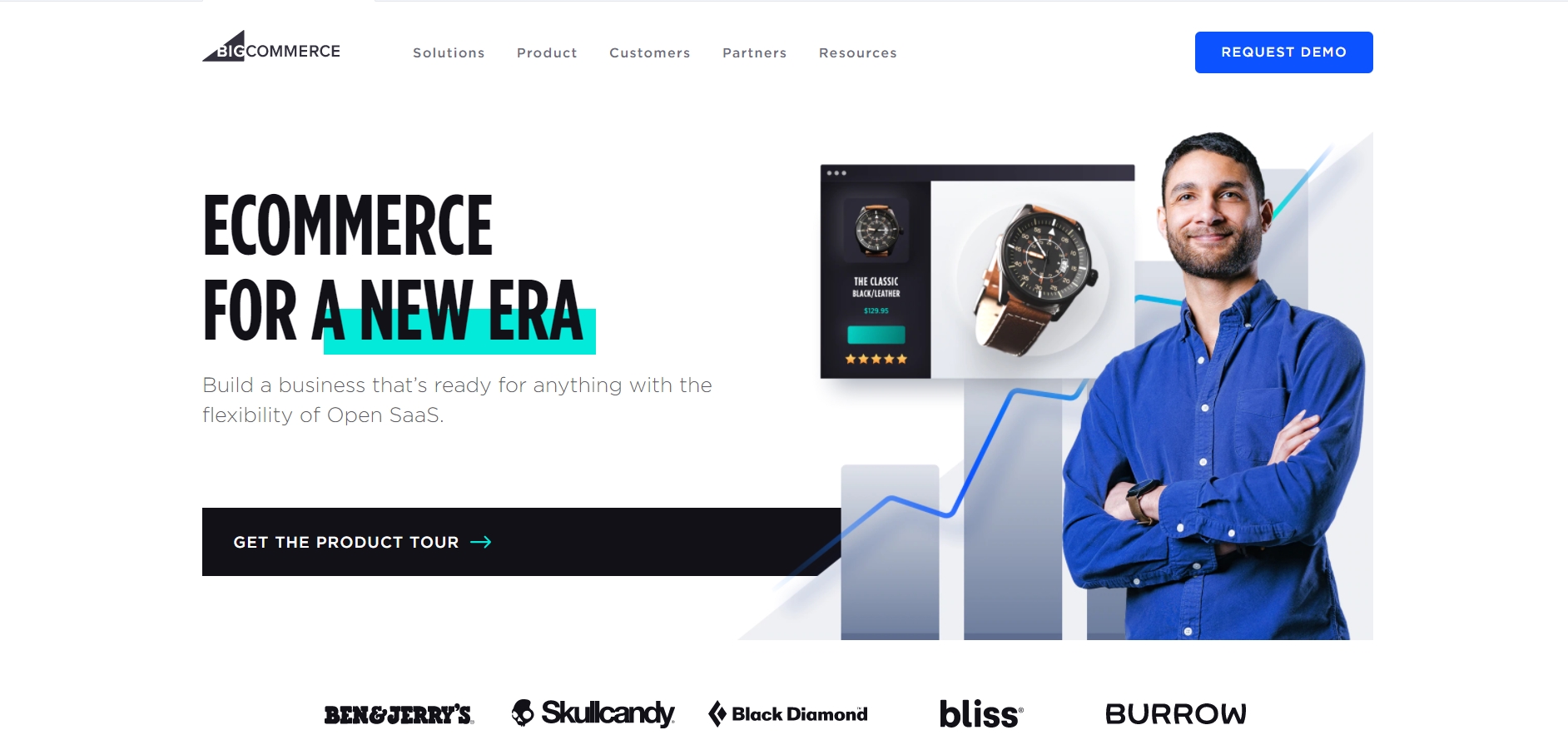
Big-commerce is an e-commerce CMS platform where users can sell their products online. Big-commerce is a Software as a Service program, which means that you do not need a web hosting account to create your store on BigCommerce. You also don’t have to install BigCommerce anywhere or configure other things. Once you sign up, your store will be ready to sell products!
Big-commerce works as a Software as service, which means we don’t need to buy the software. You just have to pay monthly charges to big commerce for using their software. Big-commerce offers a wide range of customizable themes. We can sell physical and digital products online. It also provides some marketing tools which will help you to grow your business. It has pros and cons both, let’s see each one by one.
Pros
- BigCommerce offers a trial plan for the users so that you can try the big commerce CMS platform before actually purchasing it. We can use BigCommerce before committing.
- BigCommerce offers a free domain to get you started, which will look something like like Storename.mybigcommerce.com. You can also pay for the custom domain if you don’t want to use the free domain name.
- Big-commerce also provides freedom of payment system. Customers can pay for the product via Paypal, Apple pay, Amazon pay, or debit and credit card.
- Big-commerce is also good with support, and It provides 24/7 support right from your dashboard. We can Email them, or they are always available on live chat or call.
- You also can use BigCommerce with WordPress, You just have to install a plugin. It will help you to get both CMS’s features.
Cons
- Big-commerce users have limited control over their E-store if we compare it with woo-commerce. Big-commerce has limited themes and integration options, so we have limited opportunities to use third-party integrations, affecting Business growth.
- The big-commerce developers have a limit on annual sales. Once your annual sales limit is reached, Big-commerce CMS will automatically update your plan to the next tier. It will be difficult when you have a lot of expenses.
Pricing
- Big-commerce has different plans with different features. The first plan is the Standard plan which costs $29.95. This plan will offer you basic E-Commerce features for small and simple stores. Then Big-commerce plus plan, which costs you $71.95, this plan will allow you to use abandoned cart options. The third plan is a Pro plan which costs you $269.96. This plan will help you to get custom SSL and advanced product filtering.
6. Wix

WIX is a popular CMS platform, But it has many limitations. Wix offers drag and drops site builder to create web pages. You will find hundreds of free templates on Wix. It also provides Web Hosting and domain name. You can choose a free or paid domain name offered by WIX. Wix also provides an app market that helps you to add extra functionality to the website. Wix offers attractive layout designs for small businesses like restaurants, online stores, etc. These layouts are already mobile optimized.
Wix offers customization, but its fundamental structure can’t be changed. They also have different category plans for different requirements. A beginner can easily understand the functionality. And it also offers a free plan. Now, let’s see its pros and cons one by one.
Pros
- Wix’s drag-and-drop design tools offer you to create an attractive and modern website in minutes. It’s less costly for a small business and personal websites. Premium templates are available with other plans, but with free templates too, you will have a great experience.
- The user experience on Wix is great!
- You’ll also receive guidelines while creating your first website. The Wix interface is intuitive and functional.
- The true benefit for beginners, even if you’re not sure about Wix after a trial period. You can extend your trial period for 5$ per month. It is a good rule because other CMS platforms will charge you higher with a one and two-year contract.
- Wix also offers you an App market, and it will help you add more functionality to the website. It’s precisely like WordPress.org’s plugin service.
- Wix also provides high-level security, and your website will be safe on Wix’s hand. And, the speed will remain great, vast security is a blessing.
Cons
- We can’t remove Wix ads with starter plans. In short, with the extended trial plan of $5, we can’t remove the advertisement of the Wix from our site. To remove the ads, we have to go for another monthly plan which is more costly.
- Wix will not allow you to hav unlimited bandwidth or storage on any plan. To have a complete program, you have to go for Business and commercial plans.
- As we know, Wix offers customization but on a limited basis. As a result, Wix improves its drag-and-drop interface, but we can only drop the element on selected layout boxes. So, this type of customization will limit your creativity.
- The app store of the Wix is not an actual app store but just a service that you can add to your website. But it is an ideal solution to add third-party services to your site.
Pricing
- Its basic plan will start at 5$, and the VIP plan will cost you 39$ per month. You can also have a combo plan for 14$, which will help you have the website’s basic needs like a custom domain and remove Wix ads.
- You can also go for unlimited plans, which will cost you about 18$ per month. The final plan is the Pro plan, which will cost you around 23$; with this plan, you’ll have all the Wix CMS platform features.
7. Joomla
Joomla is an another Open-Source content management system in this list. It offers lots of free templates and extensions for the website. Just like WordPress.org, it is free to use but you need a domain and hosting account. Joomla was also released in 2005, just like WordPress. And it comes with a complete feature packet, and it offers one-click installation. Joomla is an ideal CMS for many Developers and experienced web creators. But it is also suitable for beginners.
Joomla is one of the most known CMS platforms which are available to create a website. It has a large community to help you solve the issues or gather help about the Joomla. The main goal of Joomla is to give some advanced tools to the average person who can develop a website that meets some specific needs. It has Pros and Cons both, so let’s see each one by one.
Pros
- Joomla is a legend with content management capabilities in the CMS market. You can create many types of content with Joomla’s administration panel.
- Joomla is an open-source CMS platform just like WordPress. It freely allows you to modify the codes without worrying about fees and charges.
- Joomla also allows you to create an E-Commerce store with the help of extensions. It offers powerful tools to manage your products and your E-store. So, if you’re thinking about an e-store, then Joomla is the preferable CMS platform.
- Joomla also supports content and structure flexibility, and You can easily modify and create new content like you’re editing word documents.
- Joomla is more complex than WordPress, but you can surely go with the Joomla CMS platform if you’re a beginner. A non-developer or a beginner can easily understand the functionality.
Cons
- Joomla is a complex CMS platform, so sometimes we feel difficulties creating or modifying our custom designs. In this case, we need the help of an experienced developer.
- We can add more modules with Joomla with marketplace but on a limited basis. So, if you’re looking for more additional modules and more customization, then it’s hard with Joomla.
Pricing
- Joomla’s cost is $199 per user, but you can go with the free version too. You can also use the Open-source version of Joomla. However, With the paid subscription, you will get access to many extensions from the repository.
8. Blogger

Blogger is a free blogging tool introduced by Google. It is a weblog publishing tool that allows you to create free blogs. You can create an account on Blogger.com using your Gmail account. Blogger will give you unlimited space for hosting blogs as well as their features and unlimited bandwidth. Blogger also allow you to monetize your Blog, and you can see how your blog grows. Blogger customization interface will enable you to choose a template and customize it as per your requirements. It’s a powerful tool, and you can customize everything with it.
Blogger.com offers you to create unlimited posts with unlimited media files, youtube videos, and photos. After WordPress, Blogger is the world’s second-highest chosen CMS platform by blog creators. You can easily connect your Blog with Adsense and Affiliate marketing. In short, it is an all-in-one tool for bloggers. Many famous companies use Google’s blog tool as their blogs. But it also has some Pros and Cons. Let’s see each of them one by one.
Pros
- As we know the Blogger.com provides unlimited bandwidth for every Blog you create. It means that you don’t have to worry about the server even if you have 50,000 live users on your site right now.
- Blog.com provides a WYSIWYG editor. It helps you to create compelling content and easily upload media files. Mainly it will help you to save your time.
- With Blogger.com, you don’t need to learn programming, and it gives you an excellent interface that makes customization easy. But you can also use HTML/Javascript to improve your Blog.
- We can create 100 blogs with a Single Gmail account for free.
- With a free blogging platform, you can create a backup with all of your blog content. You can create a Template, Post, Comments backup in an archive file in just one click.
- Blog.com also helps you create a private blog, So, your Blog will only be accessed by your invited reader or selected users.
- We can quickly transfer our Blog using Blogger blog backup. So Blogger.com offers easy portability or migration.
Cons
- Google bloggers impose spam checks on every 50 posts in 24 hours. So you need to fill the spam check to publish the post after you reach the blog post limit.
- You can’t directly delete the Blog, and it takes 90 days to delete the Blog completely.
Pricing
- It’s entirely free for everyone who wants to create a blog. Also for those, who are looking for the best CMS platform to create and manage a Blog.
9.PrestaShop
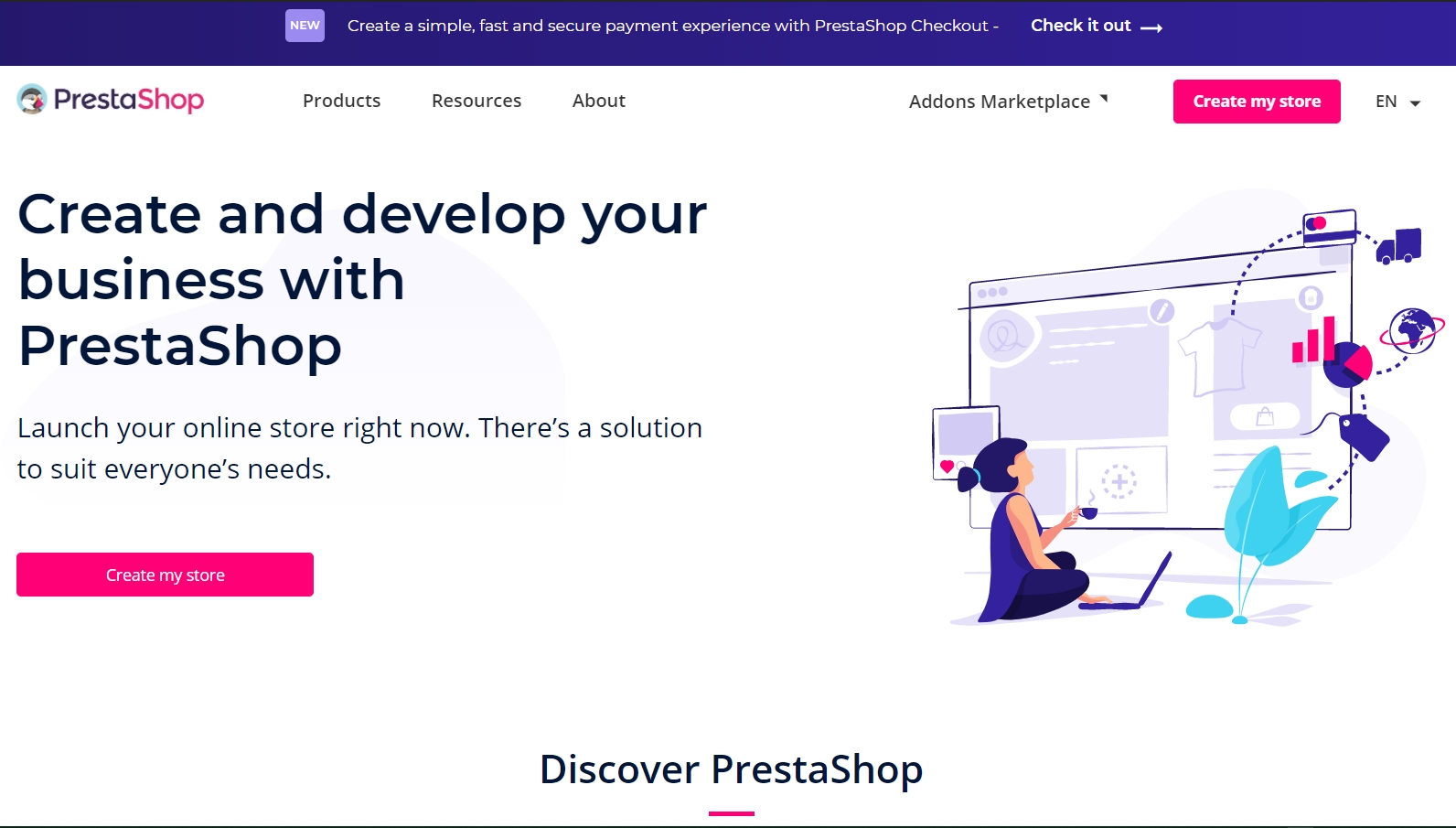
Presta shop is also an open-source CMS platform for E-Commerce websites. It was introduced in 2007; After that, PrestaShop gained popularity for E-Commerce solutions. Now, PrestaShop provides its management to 125k E-Stores worldwide. There’s no comparison of PrestaShop in case of reliability and fantastic user experience. You can host a Prestashop’s E-Store by yourself.
It has the most straightforward installation process, and the slow internet users can also easily use the PrestaShop on their devices. It is helpful for many merchants looking for an E-Store in the lowest investments; PrestaShop is a good CMS platform. You don’t even need any technical knowledge to create an e-store with a PrestaShop. It has a user-friendly interface which is an essential factor for an ideal CMS platform. So, let’s see its pros and cons one by one in brief.
Pros
- PrestaShop is easy to install, and it has an easy installation process. Just download the PrestaShop files to your device from their official website. And, you can create your e-store in a couple of minutes.
- PrestaShop is an open-source CMS platform. So you don’t have to pay for the instance, and you can have an online E-Store free of cost.
- It is easy to use and to maintain an e-store using the PrestaShop CMS platform. It has a simple interface that is easy to understand, and there’s no need to have any technical knowledge.
- You can increase the site functionality with the help of the plugin’s library with more than 25000 plugins.
- Presta Shop is customization friendly too, and we can design our E-Store depending on our business needs. We can easily customize PrestaShop designs and templates, and we can add and delete features on website and change the look per our requirements.
Cons
- PrestaShop CMS platform can be an excellent choice for small vendors because this free software will not support large and complex projects. So, you have to migrate your E-Store to another CMS which will easily handle your traffic.
- It also offers unprofessional designs for your e-store. This design is suitable for small and local vendors, but it will look awkward on large-scale e-stores. There are so many complaints available regarding Prestashop design templates.
Pricing
- Prestashop is Free to use as it is an open-source system. However, We need the domain name and the web hosting to take our Prestashop store live! So, the pricing will be same as WordPress.
10.WordPress.com
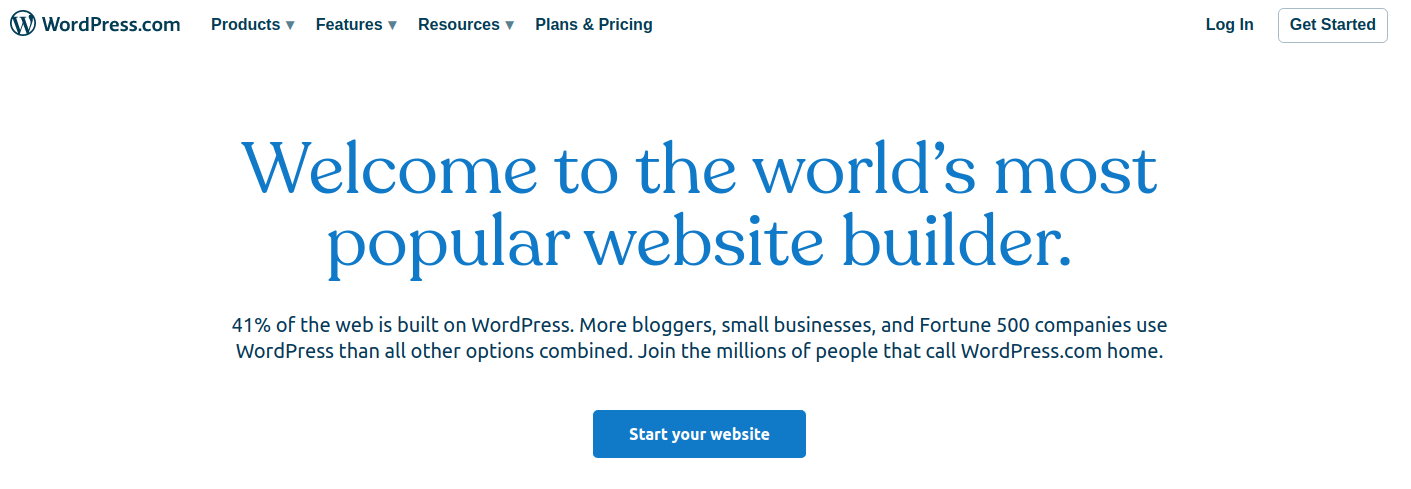
WordPress.com is also a free Software-as-a-Service CMS if you just want to get started. It is normal to be confused between WordPress.org and WordPress.com. With WordPress.com, you will get an all-in-one CMS platform. You can purchase a domain and subdomain with WordPress branding. There are six pricing plans available for hosting. WordPress.com is a good choice for bloggers.
The hosting service plan starts with a personal account worth $48 per year. But its most expensive plan is VIP which starts from $5000 per month with premium services. It is the easiest way to create a blog in a couple of clicks. Create an account, upload your posts and host it on the web according to the plan selected. Let’s see its pros and cons.
Pros
- WordPress.com is an easy CMS platform, and anyone can easily create a blog and publish it.
- It is an all-in-one CMS platform, and it will also offer domain names free with WordPress labels.
- It’s free up-to 3 GB of space. After that, You have to switch to a higher plan with more storage capacity.
- We can be free from updates and backup; WordPress.com will take care about your Blog and your CMS configuration.
Cons
- They can place ads on your Blog with the Free version. Your clients and blog readers can see those ads, but you can’t make money from them. If you want to remove the ads, you have to switch to a personal plan that costs you $49.
- We’re not allowed to sell ads with WordPress.com, and it has a limit to monetize your site. It has an Advertising program that will help you to place ads on your Blog called WordAds. But you must have a high-traffic site to apply for WordAds.
- We can not upload or install the plugins; WordPress.com provides inbuilt jetpack features which are pre-activated. You can add more features like this with a higher plan which costs $300.
- We can not install any site tracking platform like Google Analytics. We’re restricted to their stats. But the Business plan users can install Google Analytics.
Pricing
- Free – Limited plan with 3GB of storage.
- Personal – $48 per year
- Premium – $96 per year
- Business – $300 per year
- eCommerce – $540 per year
- VIP – $5000 per month
Conclusion: There are hundreds of Content management systems available in the market. However, All of them have different business models and different functionalities. Mainly, there are two types of platforms. Either you can use an Open-source Content managament system and host it on your own server. Or, you can pay a monthly or yearly subscription fees to the companies to take care of your blog. We discussed both the types of CMS in this list in detail. You can select the one that fits your requirements the best.
If you have questions, Please let us know in the comment section given below. We are happy to help!

